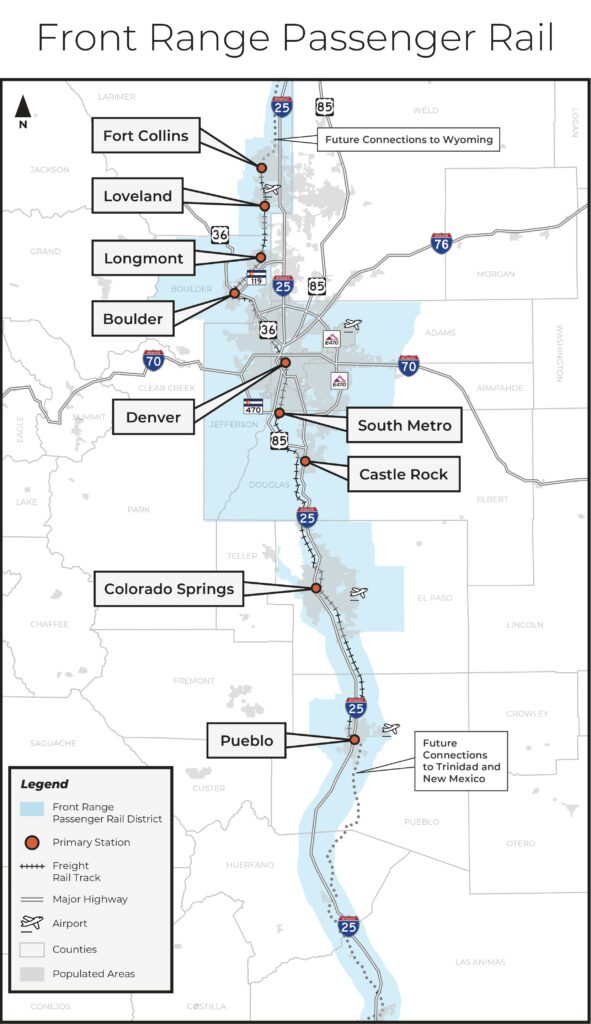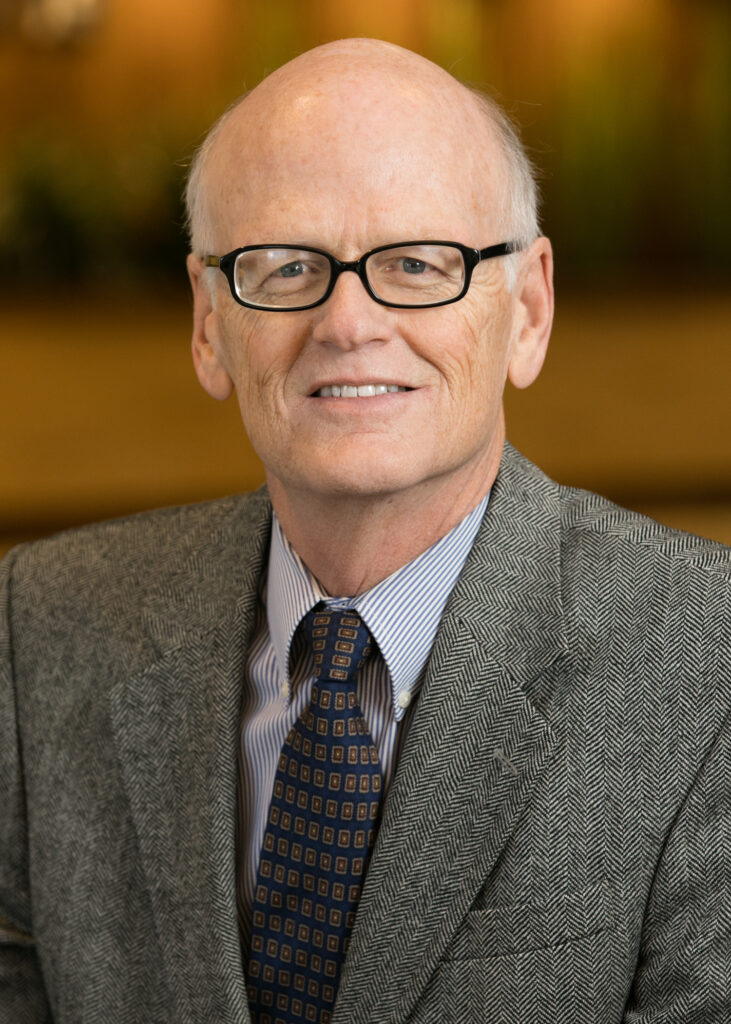This article supplements my most recent post on state initiatives dealing with climate change in Colorado. The first in the series outlined federal policy established in President Biden’s executive orders and federal legislation. The second article reviewed some of the most significant federal agencies’ initiatives that implement federal policy. The third article reviewed initiatives at the state level in Colorado. This supplement tops off the state initiatives article and focuses on transit-related legislation.
A Vision for Improved Transit That Gained Traction in 2010
Fourteen years ago, in 2010, the Rocky Mountain Rail Authority completed a feasibility study for high-speed passenger rail along I-25 and I-70.
In 2017, the Colorado Southwest Chief Commission was legislatively repurposed via Senate Bill 17-153 to become the Southwest Chief & Front Range Passenger Rail Commission that worked to facilitate implementation and operation of future passenger rail along the Front Range and Interstate 25.
In 2018, the Colorado legislature made a $2.5 million general fund transfer to fund the commission, including the development of a rail passenger service plan for the Front Range corridor.
The commission and the Colorado Department of Transportation (CDOT) are now working with the U.S. Department of Transportation (USDOT) to set key priorities such as streamlining environmental review and reducing pressure on key freight corridors by moving people off congested highways.
And, then the big one! On November 15, 2021, President Biden signed the Infrastructure Investment and Jobs Act (Public Law No. 117-58) that authorized federal funds for a multitude of transportation projects throughout the country including:
Roads, bridges, and major projects; passenger and freight rail; public transportation; airports and federal aviation administration facilities; ports and waterways; safety; and electric vehicles, buses, and ferries.
$90 billion will be allocated to transportation projects, and Colorado wants its share.
The Front Range Passenger Rail District – Linking Pueblo, Colorado Springs, Denver, and Fort Collins
One focus for Colorado is (1) development of a passenger service rail linking Pueblo, Colorado Springs, Denver, and Fort Collins – a 173-mile corridor that contains the majority of Colorado’s population, and (2) expansion of the commuter rail system.
Along with benefits to the state’s economy and quality of life, one major objective of the proposed passenger service rail is to reduce highway vehicle traffic along this major corridor, reducing greenhouse gas emissions from those vehicles.
To further those goals, in 2021, the Colorado legislature passed Senate Bill 21-238 creating a special front range passenger rail taxing district (FRPRD) made up of all or portions of 13 counties along Interstate 25 for the purpose of planning, financing, constructing, and operating an interconnected passenger rail system along the front range. The area that comprises the district extends from Wyoming to New Mexico.
The FRPRD must work with (1) the regional transportation district (RTD) to ensure interconnectivity with any passenger rail system operated by or for the RTD and (2) Amtrak on interconnectivity with Amtrak’s Southwest Chief, California Zephyr, and Winter Park Express trains.
The FRPRD must also coordinate with the CDOT to ensure that any system is well-integrated into the state’s multimodal transportation system.
The district must plan, finance, construct, and operate the system and has the following powers:
- Subject to the approval of the voters of the district and other specified limitations, the power to levy a sales and use tax, to exercise specified taxing authority common to special districts within the district, and to issue bonds;
- Subject to the approval of the owners of property within a two-mile radius of any existing or proposed passenger rail station, the power to create a station area improvement district with the authority to levy additional sales and use tax, special assessments on real property, or both, to cover the costs of construction, operation, and maintenance of the station;
- The power to enter into public-private partnerships; and
- The power to employ its own personnel or contract with public or private entities, or both, for the operation and maintenance of the system.
The district’s website describes plans for the system that extends from the Wyoming to the New Mexico border.

Ballot Measures for Passenger Service Rail
Senate Bill 21-238 also authorizes the district to pursue ballot measures to fund the project. In spite of strong pressure from the governor’s office to pursue the tax measure in 2024, the executive committee of the district’s Board of Directors decided to delay the measure until 2026. The full board is meeting May 31, 2024, and could change that recommendation, but it’s not likely. CPR News reported on May 21, 2024, that at least five of the eight members of the board’s executive committee said they support waiting until 2026 at the earliest. That prediction came true at the district’s board meeting on May 31 – there will be no ballot measure until 2026.
The district is still waiting for the CDOT to finalize its Service Development Plan (scheduled for completion in 2025) that is designed in part to address the costs, routes, and schedule for the system.
The scope of work for the CDOT plan states:
Within SB 21-238, there are specific planning benchmarks that must be reached before any potential ballot initiatives can be referred. Before a 2/3rds vote by the Board of Directors, a Service Development Plan, Operations Plan, and Financial Plan must be published. These three benchmarks will be the initial technical goals of the incoming Front Range Rail District.
The B-Line of the Regional Transportation District – Shorter Route – Hefty Cost
Along with an extensive bus system, the RTD operates more than 50 light and commuter rail stations throughout the Denver metro area. Always short of money, a report just released by the Common Sense Institute poses the dilemma the district faces:
RTD is at a fork in the railroad. What began as a relatively small-scale bus operation has grown to one of the Denver metro area’s most expansive pieces of infrastructure and a political arena of its own. Increasingly, the public is being asked to put more confidence into an organization of which it has cause to be skeptical.
The organization’s budget has grown even as it has not yet delivered the 119 miles of FasTracks rail to Longmont and Boulder voters approved in 2004. With days left in the 2024 legislative session, the General Assembly passed SB24-230, which creates a new oil and gas production fee, the revenue from which directs revenue to go towards expanding transit service, frequency, ridership, and fund passenger rail projects. The bill specifies these funds be used in part to finish the long-awaited FasTracks rail project that has, to date, cost $72 million per completed rail mile. In the interim between the 2024 and 2025 legislative sessions, lawmakers are proposing to study the effects of making RTD’s board partially appointed, rather than purely elected as it is now. The governor is planning to introduce a Front Range commuter rail to the public this November, which will theoretically cooperate with RTD for ridership and the attached federal funding.
The B-line commuter train currently runs from Westminster to Denver’s Union Station downtown. The RTD has been planning to extend the line to serve Longmont and Boulder, but the $1.5 billion cost has delayed progress – with some projecting completion sometime in the 2040s.
To help alleviate the financial crunch, the legislature passed Senate Bill 24-184, which is designed to raise an estimated $58 million annually through imposition of fees on rental cars – $2 per day fee for electric vehicles and $3 per day for gas-powered models. The money will be allocated to fund multimodal transportation projects, compete for federal rail grants, and to make the necessary infrastructure and safety improvements along the Front Range rail corridor.
And as referenced in the Common Sense Institute’s report, Senate Bill 24-230 will raise over $100 million each year for RTD’s operations and local transit projects. The money will come from the imposition (after July 1, 2025) of a production fee for clean transit to be paid quarterly by every producer of oil and gas in the state.
In his press release, Colorado Governor Polis said,
This landmark legislation brought together the oil and gas industry and environmental advocates to protect our air quality while making historic investments in public transportation. I am excited to see the ways these investments will improve our air quality and modernize transportation and transit in our great state.
Transit Passes and The Zero Fare Transit Fund
Finally, Governor Polis also signed Senate Bill 24-032 that:
- Creates a statewide transit pass exploratory committee within CDOT to produce a viable proposal for the creation, implementation, and administration of a statewide transit pass;
- Amends the ozone season transit grant program which, among other things, makes the grant program permanent;
- Authorizes the Zero Fare for Better Air Program for a third year. The grant program is implemented by the Colorado Energy Office to provide grants to the RTD and a transit association to provide fare free year-round transit services for individuals who are 19 years of age or younger; and
- Directs the state treasurer to transfer $10 million from the multimodal transportation options fund to the zero fare transit fund.
Next Up
Part 4 of this series will focus on some of the most significant initiatives that affect or are implemented at the local level.
This post was drafted by John L. Watson, an attorney in the Denver, Colorado office of Spencer Fane LLP. For more information, visit www.spencerfane.com
Click here to subscribe to Spencer Fane communications to ensure you receive timely updates like this directly in your inbox.
